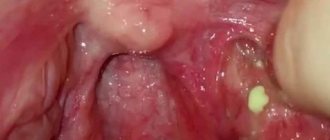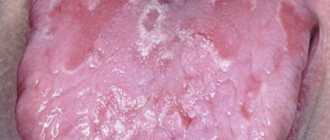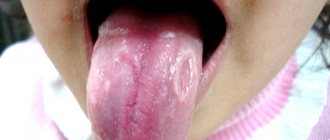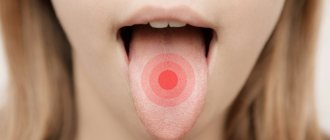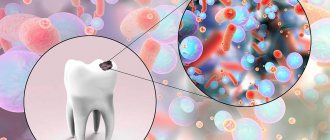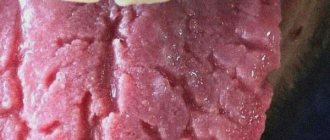Causes of stomatitis
In children, as in adults, stomatitis can be caused by viruses, fungi, bacteria, allergies and injuries. About six months after birth, the child loses the immunity received from the mother, the protective power of the immune system changes, and the child’s body becomes more susceptible to infections. The oral mucosa in children is more delicate and easier to injure; children also more often “bite” their cheeks after dental treatment due to a temporary loss of sensitivity after anesthesia, which causes traumatic stomatitis.
Children are not always motivated to brush their teeth, so poor hygiene can also cause stomatitis.
With the following diseases, stomatitis is observed in children much more often: chronic tonsillitis, diabetes mellitus, heart defects, chronic hepatitis.
What causes pathology to develop?
The appearance of hair on the surface of the tongue is always a consequence of some phenomena and processes occurring in the patient’s body. In fact, this is a symptom that acts as a complication against the background of a certain pathological disorder in the functioning of internal organs and systems. Most often, the cause of “hairy” tongue is one of the following factors:
- fungal infection, such as stomatitis,
- disruptions in metabolic processes,
- problems in the digestive system,
- long-term use of a particular group of medications,
- imbalance of oral microflora.
This is what a fungal infection on the tongue looks like
“I also encountered the same problem at one time. Thank God, I noticed it at the initial stage, when the tongue was just beginning to become covered with something like stubble. I was, of course, stunned. I immediately went to my dentist, he cleaned me, healed caries in one tooth, and prescribed applications to the tongue. Judging by the tests, the whole problem is due to the course of antibiotics that I took shortly before. Now everything seems to have passed, but I was in a very early stage, I don’t know if this can be treated in advanced cases...”
Kir!85, Ekaterinburg, from correspondence on the forum www.32top.ru
A “hairy” tongue is a phenomenon that requires a professional approach to treatment. Therefore, you should not make independent attempts to cleanse the organ, since in this case the situation can only get worse. It’s better not to take risks and entrust the solution to the problem to professionals.
Classification of HRAS (chronic recurrent aphthous stomatitis)
| CLASSIFICATION | A COMMENT | ||
| classification: | According to the degree of damage to the mucous membrane: | a comment: | 1) Superficial (catarrhal, fibrinous) 2) Deep (ulcerative, necrotic) |
| classification: | According to the clinical course: | a comment: | 1) acute 2) chronic |
All types of stomatitis occur in children, but the most common are: herpetic, candidal and traumatic stomatitis.
Acute herpetic stomatitis
It occurs most often, and mainly affects children from 10 months to 3 years.3 The appearance of rashes is preceded by inflammation of the lymph nodes.
With a mild form
In acute herpetic stomatitis, the temperature rises to 37-37.5°C, the general condition is satisfactory, slight swelling and redness may occur on the gums, then up to six blisters appear, which burst with the formation of painful aphthae surrounded by a red rim.
Afta is a round-shaped erosion. Aphthae may merge together. The rash appears once, and after 1-2 days the erosion gradually heals.
Moderate form
Acute herpetic stomatitis is characterized by deterioration of the child’s well-being, weakness, and headache. The child is capricious, has no appetite, the lymph nodes are enlarged and painful, the temperature rises to 38-39°C, the symptoms resemble ARVI. The oral mucosa is swollen, reddened, rashes appear (bubbles, then erosions) of 10-15 pieces, and often there are rashes on the face. Salivation increases, and gingivitis appears (inflammation of the gums, accompanied by bleeding). The rash may appear several times, i.e. after the old ones heal, new ones appear. Healing of erosions takes up to 4-5 days. Bleeding gums and swollen lymph nodes persist for some time after the erosions have healed.
Severe form
It begins as an acute respiratory viral infection, there is pain in the muscles, joints, tachycardia and bradycardia (increased and slow heartbeat), and nosebleeds may even be observed. In this form, the temperature is high up to 40°C, gingivitis is pronounced, the mucous membrane is bright red, swollen, the child’s lips are dry, the mucous membrane of the eyes is swollen, reddened. The rashes constantly appear again, their number can reach 100. Rashes often appear around the mouth, on the eyelids, on the mucous membranes of the eyes, between the fingers, on the earlobes. Simple gingivitis turns into ulcerative (a more severe form of gum inflammation, with the formation of ulcers), salivation increases, and bad breath appears. Recovery is long and hospitalization is often required.
What could be the consequences?
If you ignore the obvious signs of the development of pathology for too long, after a while it can lead to complications that will negatively affect the condition of the oral cavity as a whole. Experts consider the following phenomena to be possible problems in the future:
- inflammatory processes in periodontal tissues,
- deep caries,
- partial loss of sensitivity of the tongue,
- microflora imbalance,
- decreased intensity of salivary fluid secretion,
- dryness of the mucous membrane.
Pathology can also negatively affect the condition of other internal organs and systems. For example, enlarged papillae inevitably lead to rapid proliferation of bacteria, and hence problems with the gastrointestinal tract and respiratory system.
Enteroviral vesicular stomatitis (arm - leg - mouth)
Caused by enteroviruses. It also occurs in adults, but in 95.7% of cases children are affected.6 It is characterized by seasonal occurrence (summer - autumn) and group incidence.4 It is observed mainly in children under 10 years of age. Vesicular stomatitis is contagious, so it is recommended to use separate utensils and hygiene products. Characteristics for this disease: temperature 37.5-38, weakness, headache, muscle pain, rash on the palms, soles, as well as blisters on the hard palate and pharynx, which then turn into erosions that are almost not painful.
Acute pseudomembranous candidal stomatitis (thrush)
Acute pseudomembranous candidal stomatitis (thrush) occurs:
- Light shape
- Medium-heavy forms
- Severe form
The main symptom of the disease is a white or yellow coating.
With a mild form
The plaque is located in islands, most often on the tongue and cheeks. Children are restless, sleep poorly, and suck the breast sluggishly. Older children may complain of a burning sensation. The plaque is easily removed; underneath there is a bright red mucous membrane. The disease lasts no longer than 7 days.5
Moderate form
The plaque is located on the cheeks, tongue, hard palate, and mucous membranes of the lips. Under the plaque, erosions form, which sometimes bleed. The plaque is more difficult to remove. Lymph nodes are sometimes enlarged and painful. The duration of the disease is 10-15 days, there are relapses.
Moderate form
The plaque is dirty gray, almost cannot be removed, and is located on the tongue, cheeks, soft palate, tonsils, pharynx, and mucous membranes of the lips. Cheilitis appears in the corners of the mouth - inflammation of the lips. The oral mucosa is dry and inflamed. The child’s health is impaired, the child refuses to eat, and the temperature rises. Lesions in the genital area, neck folds, and between the fingers are also common. The disease is long-term, with frequent relapses.
Temperature
Temperature and a white coating may indicate an incipient sore throat. In this case, patients complain of a coated white tongue, pain when swallowing, general weakness and malaise, as well as fever. The combination of these symptoms provides grounds for diagnosing angina.
With a sore throat, the tongue becomes white and the throat hurts, while the plaque is usually very dense and difficult to remove. Taking certain medications only worsens the condition. Therefore, it is extremely important to ensure oral hygiene, to clean not only the teeth and gums, but also the tongue.
Advice! You can remove white plaque using an ordinary soft toothbrush and toothpaste. Use light circular movements to clean the surface of the tongue, being careful not to damage or scratch it. It is best to do this procedure in the morning before eating, since the plaque consists almost entirely of bacteria, and it is completely undesirable to swallow them.
Bacterial stomatitis in children
Necrotizing ulcerative stomatitis is more common in weakened children and is caused by fusobacteria and spirochetes. May be a sign of periodontal disease (progressive destruction of periodontal tissue). It is characterized by the appearance of painful ulcers, weakness, gingivitis (inflammation of the gums), enlarged and painful lymph nodes, difficulty eating, speaking, and bad breath.
Often, erosions in traumatic stomatitis can become infected through dirty hands, toys and other objects, then bacterial stomatitis develops, so it is important to pay attention to antiseptic treatment.
Traumatic stomatitis in children
A specific form of traumatic stomatitis in children is Bednar's aphthae . This is a traumatic erosion of the oral mucosa. In children, unlike adults, the mucosal epithelium consists not of four layers, but of two, so it is easily injured. The cause may be early teething, a rough nipple from the mother, or a long nipple on the bottle. Erosion is most often located in the middle of the palate or opposite the cutting edge of the teeth. The child begins to refuse food, cries, and sleeps poorly.
Traumatic stomatitis also occurs in children when wearing braces. Erosions have uneven edges, are painful, and are usually located on the mucous membrane of the cheeks and lips, less often on the tongue.
Treatment of white plaque on a child’s tongue
A white coating on a child’s tongue is most likely ordinary food debris. If it is not removed with a damp cloth and spreads to the mucous membrane of the cheeks, then this indicates the development of an infectious process.
Why does a white coating appear on the tongue of a baby during breastfeeding? As a rule, this is thrush - a fungal infection caused by yeast-like fungi belonging to the genus Candida. A white coating covers the baby's tongue and gums, the inside of the lips and cheeks. Thrush often occurs in children under one year of age. The reason is the immature immune system of infants. Thrush is a contagious disease, so to avoid it, bottles and pacifiers must be thoroughly sterilized. Older children also get thrush. Children with weakened immune systems and asthmatic children using inhaled corticosteroids are at risk. Treatment of white plaque on a child's tongue is carried out with local antifungal drugs. Important: medications should be prescribed exclusively by a doctor, since a similar picture may be a symptom of another condition in which antifungal drugs are not required. For example, diseases caused by the Coxsackie virus are often accompanied by the appearance of white “spots” on the tongue. In fact, these are painful ulcerations that disappear on their own within 3-5 days without any treatment. Therefore, if you find a white coating on your child’s tongue, you should consult a doctor and not self-medicate.
In infants, the surface of the tongue may be covered with a colored coating. How to treat a yellow coating on the tongue of a newborn depends on the condition that is accompanied by this symptom. For example, sometimes the tongue becomes coated with a colored coating from certain baby formulas. Just change your diet and your tongue will clear up. However, yellow plaque may also indicate problems with the gastrointestinal tract and respiratory infections. In these cases, treatment of the underlying disease is carried out.
Drug-induced stomatitis
Occurs when there is an allergy to a drug. Often, allergies can occur to antibacterial, antimicrobial drugs, vaccines, iodine. The mucous membrane is red, swollen, the lips and tongue also often swell, blisters appear, which burst, leaving erosion. The gums are inflamed and bleed when touched. General manifestations are possible, such as urticaria, nausea, vomiting. In severe cases, anaphylactic shock occurs (an emergency condition manifested by decreased blood pressure, shortness of breath, fainting, suffocation), Quincke's edema (an atypical reaction of the body, manifested by rapid and severe swelling)
Both conditions are extremely dangerous and require immediate action and calling an ambulance!
Diagnostics
To make a diagnosis, the doctor conducts a thorough examination of the patient. First he will try to remove the plaque. This will help eliminate the possibility of poor hygiene or consumption of certain products. Then a complete medical history is collected: what the patient eats, what medications he takes, how long ago the symptom appeared. This also helps to filter out some of the options.
After listening to the accompanying symptoms, the doctor can make a preliminary diagnosis. Additional examinations are often prescribed:
- FGDS;
- Ultrasound of the kidneys;
- ECG;
- lab tests.
The examination plan is drawn up individually and depends on the complete clinical picture.
Prevention of stomatitis in children
In children's groups, infections spread especially quickly. Therefore, if a child is infected with the herpes virus, he needs to stay at home until he recovers. Children who have been in contact with sick people should use antiviral ointments for 5 days.
If a pregnant woman has herpes or candidiasis, she should treat it before giving birth. If you have the herpes virus during the period of illness, you should use separate utensils, do not kiss children, and wear a mask.
Kindergartens and other preschool institutions must be cleaned and objects, including toys, must be treated with disinfectants.
To avoid allergic reactions, you should seek help from an allergist to identify existing allergies.
It is worth preventing a decrease in immunity; hardening works especially well in childhood. It is worth limiting your intake of fast carbohydrates, because... they create a favorable environment for the development of candidiasis. An important point is the proper nutrition of the child; regular intake of vitamins, especially vitamin C, is essential.
Tantum® Propolis
For children over 14 years of age , you can use Tantum® Propolis lozenges; they contain a lot of vitamin C, which will strengthen the immune system, and propolis has an anti-inflammatory effect, preventing the occurrence of infections.7
Find out more
Prevention of Bednar's aft is preparing the breasts for feeding, using special creams to soften the skin, prevent cracks, and it is also worth choosing the right bottle. In case of injury due to braces, you need to use orthodontic wax; here it is important to prevent the wounds from becoming infected, so it is better to treat them with antiseptic solutions and sprays.
Tantum® Verde spray will relieve pain at the site of injury and its antiseptic effect will prevent infection.8,9
